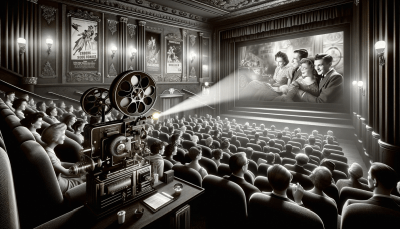Online Film School Free » Film Directing Course » The Golden Age
History of Film Directing: The Golden Age of Cinema
Table of Contents
ToggleThe 1930s to 1950s marked a period when Hollywood studios dominated the global film market, producing a plethora of classics that remain beloved today. We can’t gp through all of the directora of the area, but here are some of the prominent ones

Orson Welles: A Luminary of the Golden Age of Cinema
Orson Welles was more than just a filmmaker; he was a visionary. His contributions to the golden age of cinema have left an indelible mark, and his works continue to inspire generations of filmmakers. Here are some of the things he gave the film industrial:
1. Deep Focus Cinematography – One of the most notable techniques Welles introduced was the use of deep focus cinematography, most prominently seen in his magnum opus, “Citizen Kane” (1941). This technique allowed multiple planes in a shot—foreground, middle-ground, and background—to remain in sharp focus simultaneously.
This gave Welles the freedom to utilize the entirety of the frame, directing the viewer’s attention to multiple elements at once and creating a richer, more layered visual experience.
2. Non-Linear Storytelling – Welles was also a pioneer in non-linear storytelling, a narrative technique where events are portrayed out of chronological order. Again, “Citizen Kane” is a prime example, where the story of Charles Foster Kane is told through a series of flashbacks, each contributing a piece to the puzzle of his life. This fragmented approach to storytelling added complexity and depth, compelling the audience to actively engage with the narrative.
3. Innovative Sound Design – In the realm of sound design, Welles, with his background in radio, brought a fresh perspective. He utilized overlapping dialogues, where characters would start speaking before the previous line had finished. This created a sense of realism and spontaneity in his films.
Additionally, he employed sound bridges to transition between scenes, using audio from one scene to introduce the next, seamlessly linking narrative moments.
4. Theatrical Influences – Welles’ roots in theatre heavily influenced his directorial style. He often used long, uninterrupted takes, known as “one” shots, allowing scenes to play out in real time and capturing the energy and dynamism of live performances. This technique also showcased the prowess of his actors, as they had to maintain character and intensity for extended periods. The scene we saw earlier from Touch Of Evil is a famous example of Welles one shot
Orson Welles’ impact on the golden age of cinema is immeasurable. Beyond technical innovations, Welles consistently challenged Hollywood norms. Whether it was tackling controversial subjects or clashing with studio executives over creative control, he was unafraid to push boundaries. His films often carried social and political undertones, reflecting his deep engagement with the world around him. Beyond “Citizen Kane”, Welles continued to push the boundaries of filmmaking. Films like “The Magnificent Ambersons” (1942) and “Touch of Evil” (1958) showcased his adeptness at exploring the human psyche, societal decay, and the moral ambiguities that lie therein.
Welles often faced budgetary constraints, studio interferences, and editing disputes, but his indomitable spirit and unwavering commitment to his vision ensured that his legacy would remain untarnished. His films were not just movies; they were experiences and journeys into the human soul. While many of his techniques have become standard practice today, it was Welles who paved the way, proving that cinema could be as much an art form as it was entertainment.
Alfred Hitchcock: The Master of Suspense
When one speaks of suspense in cinema, one name invariably towers above the rest: Alfred Hitchcock. Dubbed the “Master of Suspense,” Hitchcock’s legacy in the world of filmmaking is unparalleled. His ability to captivate audiences with a blend of tension, intrigue, and psychological depth made him one of the most iconic directors of the golden age of cinema and beyond.

Hitchcock began his illustrious career in the silent film era in Britain, but it was in Hollywood where he truly made his mark. Films such as “Rear Window” (1954), “Vertigo” (1958), and “North by Northwest” (1959) epitomized his unique style – a blend of meticulous craftsmanship and profound understanding of human psychology. His films were often layered with deeper themes of obsession, duality, and the darker aspects of humanity, all wrapped up in a gripping narrative.
Hitchcock’s Innovative Directing Techniques
Hitchcock’s contributions to the world of cinema are immeasurable, and his legacy remains influential to this day. Let’s delve deep into the directing techniques that Hitchcock introduced and his monumental contributions as a film director:
- Use of the MacGuffin – One of Hitchcock’s signature techniques was the use of a ‘MacGuffin,’ a plot device that propels the narrative forward, but whose specific nature is unimportant to the overall story. It could be an object, a place, or even a person. The audience, as well as the characters in the film, may believe it to be of utmost importance, but the MacGuffin is merely a tool to set the story in motion. Classics like “North by Northwest” and “The 39 Steps” are notable examples of this technique.Here is Hitchcock Explains What a MacGuffin Is
- The Unseen and the Power of Imagination – Hitchcock was a firm believer in the power of the audience’s imagination. Instead of showing graphic or explicit content, he often left certain events to the viewer’s imagination, making scenes even more terrifying. This technique is prominently displayed in “Psycho,” where the infamous shower scene is more about what isn’t shown than what is. This shower scene, not only broke conventions but also set new standards for horror and suspense.
- Point of View (POV) Shots – Hitchcock was a pioneer in using POV shots to put the audience directly into the shoes of the characters. This technique not only built empathy but also intensified the suspense. Films like “Rear Window” masterfully employed this technique, making viewers feel the same tension and paranoia as the protagonist.
Alfred Hitchcock’s cinematic masterpiece, “Rear Window“, exemplifies the effective use of Point of View to immerse the audience into the film’s narrative. Set primarily in the apartment of L.B. “Jeff” Jefferies, a photojournalist confined to a wheelchair due to a broken leg, the movie offers a unique perspective into the lives of various neighbors through Jeff’s rear window. The majority of the film is seen through Jeff’s eyes, making the audience complicit in his voyeuristic activities and Hitchcock’s use of the POV technique intensifies the suspense and the palpable sense of claustrophobia. In the film’s climax, as the suspected murderer confronts Jeff, the use of POV is masterful.
- Misleading the Audience – Hitchcock loved playing with the audience’s expectations. At the beginning of “Psycho”, the narrative revolves around Marion Crane, played by Janet Leigh. The film spends a significant amount of time establishing her character, her relationship, and her decision to steal money from her employer. Hitchcock even accentuates the tension surrounding her theft, her subsequent escape, and her paranoia of being caught, making viewers invested in her storyline.
However, Hitchcock masterfully diverts expectations when Marion checks into the Bates Motel. After a significant interaction with Norman Bates, the seemingly mild-mannered motel manager, Marion decides to return the stolen money. Just as the audience is adjusting to this new development, Hitchcock delivers one of the most shocking scenes in cinematic history: Marion is brutally murdered in the shower by an unseen assailant.
Not only is the film’s apparent protagonist killed off less than halfway through the film, but the narrative undergoes a dramatic shift. The stolen money, which seemed like a major plot point, becomes irrelevant. Instead, the focus shifts to the mysteries of the Bates Motel, Norman’s relationship with his mother, and the investigation into Marion’s disappearance.
This bait-and-switch technique was groundbreaking at the time and serves as a testament to Hitchcock’s brilliance in subverting audience expectations and crafting unpredictable narratives. This unpredictability became one of the hallmarks of his storytelling.
John Ford – An icon in the pantheon of filmmakers
John Ford stands as, particularly in the Western genre, where his work has come to define the visual and thematic templates that many later directors would follow. Ford’s contributions to cinema during the Golden Age are not merely artistic; they are foundational, influencing the craft and language of film in ways that are still felt today.
Ford’s directing techniques were as varied as they were influential. He had a penchant for on-location shooting, especially in the stark, majestic landscapes of Monument Valley, which became a visual signature in his films. This preference not only gave his movies an authenticity that studio backdrops could not match but also used the natural environment to enhance the storytelling, making the setting a character in its own right.
Composition was another of Ford’s strengths. His frames were meticulously crafted, often employing deep focus that allowed multiple layers of action to unfold within a single shot. This technique not only enriched the visual texture but also underscored the interconnectedness of characters and their environment. Ford’s use of doorways and windows to frame scenes was a method that added depth and perspective, creating a sense of intimacy or isolation depending on the context.
One cannot discuss Ford’s directorial techniques without mentioning the Fordian hero—an archetype embodied by actors like John Wayne. Ford’s heroes were men of few words, whose moral codes were etched into the lines of their faces as much as into their actions. These characters were often caught between personal codes of honor and the changing world around them, a theme Ford explored with great nuance.
Ford’s influence extended beyond the screen to the very structure of filmmaking. Ford’s sets were disciplined, and he was famous for his economy of shooting. Rarely wasting a frame, he shot only what he needed, which allowed him to work quickly and within budget—an approach that studio heads appreciated during the financially conscious Golden Age.
Ford was also a master of visual storytelling, with a particular genius for composition and juxtaposition. His cross-cutting between action sequences and more intimate moments built tension and provided relief in equal measure, a technique that would be emulated by countless filmmakers after him.
As a film director, Ford did not just make films; he sculpted them from the raw materials of the American mythos, presenting tales of courage, community, and rugged individualism that have become part of the cultural fabric. His contributions during the Golden Age of cinema were not merely films but the very lexicon of cinematic language that would tell America’s story to the world.
Billy Wilder
Billy Wilder carved out a distinct niche in the pantheon of cinema’s greatest directors. His remarkable versatility across genres, from film noir to comedy and romance, cemented his status as a cinematic master,that was expert at capturing the human condition in all its shades.
Billy Wilder pioneered the use of the fast-paced, witty dialogue that became a staple of classic Hollywood storytelling, especially evident in films like “The Apartment” (1960) and “Some Like It Hot” (1959). His dialogue was not merely about quick exchanges but was layered with subtext, providing a depth that invited audiences to engage more intimately with his characters.
One of Wilder’s notable directing techniques was his ability to construct a scene using sharp dialogue and tight framing to enhance the storytelling. In “Double Indemnity” (1944), he utilized close-ups and tight two-shots to create a palpable tension between characters, a technique that intensified the drama and propelled the narrative forward. Wilder’s framing often composed shots to draw the viewer’s eye to subtle details that were significant to the story or the psychological state of his characters.
Moreover, Wilder’s contributions to the language of film noir cannot be overstated. By using construct lighting and twisted camera angles, he evoked a sense of moral ambiguity and psychological complexity. This visual style, combined with his sharp, cynical perspective on human nature, became a Wilder trademark, setting a high bar for the noir genre.
In comedy, Wilder’s direction in “Some Like It Hot” demonstrated his skill in balancing slapstick, wit, and farce with an underlying commentary on gender and society, all while never compromising the film’s pacing or full narrative. His comedic timing was perfect, often using visual gags and clever editing to land a joke effectively.
Wilder’s contributions to cinema also included his collaborative approach with actors. He had a gift for drawing out nuanced performances, often working closely with actors to refine their portrayal of complex characters.
Billy Wilder’s enduring legacy as a director is also tied to his foresight in addressing themes that were ahead of their time, such as the exploration of corporate wrongdoing in “The Apartment” or the satirical take on Hollywood itself in “Sunset Boulevard” (1950). His work resonated with authenticity and a keen observer’s eye.
His films are studied for their structural perfection, their innovative use of the medium, and their incisive social commentary. Billy Wilder crafted enduring cinematic experiences that continue to educate and inspire filmmakers even today. His contributions are a testament to the power of film as both art and commentary, a combination that defines much of the Golden Age of Hollywood and Wilder’s illustrious career within it.
Frank Capra: The Heart of America’s Golden Age
Frank Capra, born in 1897, rose to prominence during the Golden Age of Hollywood with a series of films that captured the American spirit. Unlike his contemporaries who focused on grandiose spectacles, Capra’s mastery lay in his ability to weave narratives that resonated deeply with the common man. His films, often characterized by their optimism and moral messages, reflected the hopes and struggles of everyday Americans during the tumultuous 1930s and 1940s.
Defining Works
Capra’s most defining works, including “It Happened One Night” (1934), “Mr. Smith Goes to Washington” (1939), and the perennial classic “It’s a Wonderful Life” (1946), are notable for their blend of humor, romance, and social commentary. His approach to storytelling, often focusing on characters who triumph over adversity through integrity and kindness, became a signature of his style and endeared him to audiences.
Capra’s impact on cinema was profound, earning him multiple Academy Awards and solidifying his place as one of the most influential directors of his time. His philosophy of filmmaking, emphasizing the human spirit and the potential for goodness, left a lasting imprint on the industry. He was a visionary who believed in the power of film to uplift and inspire, a sentiment that defined his career and legacy.
John Huston: A Master of Adaptation and Realism
John Huston, born in 1906, emerged as a formidable talent in Hollywood, known for his gritty realism and masterful adaptations of literary works. His directorial debut, “The Maltese Falcon” (1941), is often considered one of the greatest film noirs ever made, showcasing Huston’s skill in creating tense, atmospheric narratives.
Huston’s versatility as a filmmaker was evident in his ability to tackle a wide range of genres, from film noir to adventure, drama, and comedy. His works such as “The Treasure of the Sierra Madre” (1948), “The African Queen” (1951), and “The Man Who Would Be King” (1975) exhibit a keen eye for character development and a flair for storytelling.
Huston’s influence on cinema is marked by his unflinching approach to storytelling and his ability to bring complex characters to life. He was known for his collaborative approach with actors, often drawing out career-defining performances. A two-time Academy Award winner, Huston left behind a diverse and rich body of work that continues to be studied and admired for its craftsmanship and depth.



